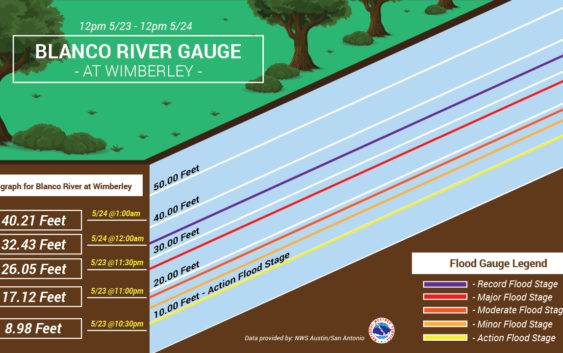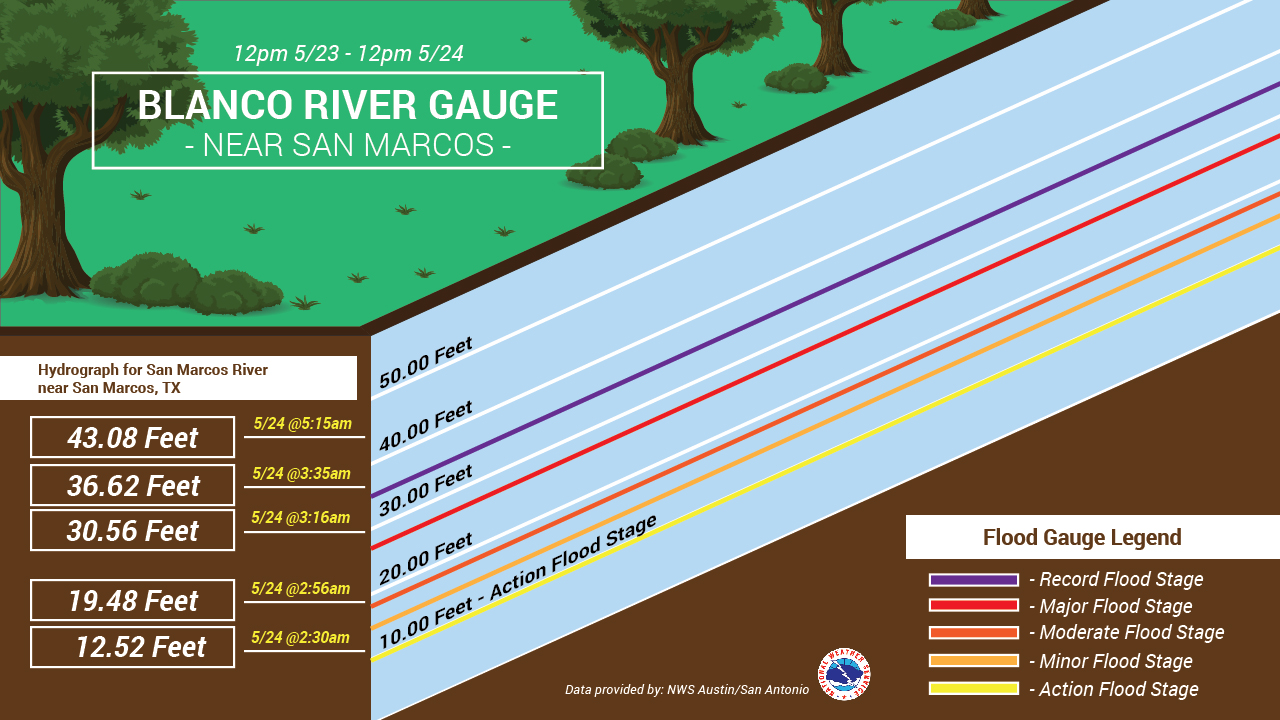4 years ago today, 'tidal wave of water' hit Wimberley, causing catastrophic flooding

SAN ANTONIO – Thursday marks four years since heavy rain that triggered record flooding began to fall in the Texas Hill Country.
The towns of Wimberley and San Marcos were ravaged by what was called a “tidal wave” along the Blanco and San Marcos rivers.
Thirteen fatalities were reported across the affected area, and the aftermath of the storm was devastating for both communities.
Large piles of debris and trees littered both towns and water flooded parts of Interstate 35, bringing rescue efforts and traffic to a standstill until the water receded.
Hays County Emergency Management officials said the Blanco River swept away entire blocks of homes in Wimberley and reportedly destroyed between 350 to 400 residences while more than 1,000 residents were displaced or left homeless immediately after the storm.
Timeline of “tidal wave of water”
According to the National Weather Service, most locations across South Central Texas had already received above normal amounts rain (2 to 4 inches) during May 2015 leading up to Memorial Day weekend.
Wet conditions on the ground meant any new rain would run-off directly into rivers, streams and areas prone to flash flooding.
The ingredients for heavy rainfall and severe thunderstorms came together Saturday afternoon, May 23, across the Hill Country.
According to the National Weather Service, 6 to 8 inches of rain fell across Bandera, Kerr, Kendall, Blanco, portions of Comal and Hays counties.
The NWS reported a maximum of 10 to 13 inches of rain across southern Blanco and northeast Kendall counties.
Most of the rain fell from Saturday afternoon through early Sunday morning, May 24, leading to an unprecedented rise in the Blanco and San Marcos rivers.
The Blanco River gauge at Wimberley showed the water level rose from nearly 9 feet at 10:30 p.m. Saturday to more than 40 feet by 1 a.m. Sunday, eclipsing the record of 32 feet.
(Data below courtesy of National Weather Service.)
The Blanco River gauge near San Marcos showed a similarly rapid rise as a flash flood emergency was issued at 1:25 a.m.
The powerful surge of water from the Blanco River then arrived just before 3 a.m. Sunday when the San Marcos River was already nearly 20 feet.
The San Marcos River crested at just over 43 feet two hours later, according to the National Weather Service.
(Data below courtesy of National Weather Service.)

Emergency officials rushed to save people and conducted several high water rescues through the morning.
The story that garnered the most national attention was of a group of nine who were vacationing inside a home that was swept off its foundation by the raging river.
Jonathan McComb, his wife, Laura Schultz McComb, 6-year-old son Andrew and 4-year-old daughter Leighton were inside with Ralph and Sue Carey, their daughter, Michelle Charba, her husband, Randy and their 4-year-old son, Will.
The home was ripped off its stilts along the river and crashed into a ranch road bridge, sending the nine people people in different directions. Jonathan McComb and his family’s Labrador, Maggie, were the only survivors.
McComb told the Corpus Christi Caller-Times the family “had flashlights looking down river and saw the bridge coming.
“We braced for it,” McComb told the Caller-Times. “The whole second story went, glass breaking everywhere, 2-by-4s flying.”
Jonathan McComb suffered multiple injuries, but was pulled from the bank of the river by a good Samaritan. However, he never saw his family or the other members of the group again.
The bodies of six people inside the home were located days after the flood, but the remains of Leighton McComb and Will Charba have not been located to this day.
In May 2017, KRIS-TV reported TEXSAR search crews still periodically go out and search for the remains of the children.
“We will never give up hope, we will always believe we’re going to find them,” Noakes told KRIS-TV.
Other confirmed victims of the flood were identified as Dayton Larry Thomas, 74, Jose Alvaro Arteaga-Pichardo, 29, and Kenneth Reissig, 81.
Two days after the flood, Gov. Greg Abbott signed a disaster declaration for more than 20 Texas counties and declared a state of emergency for the region.
The recovery process has been a slow and painful one, but people in the area have shown resilience and courage as they continue to rebuild from the biggest recorded floods in state history.
Copyright 2016 by KSAT – All rights reserved.